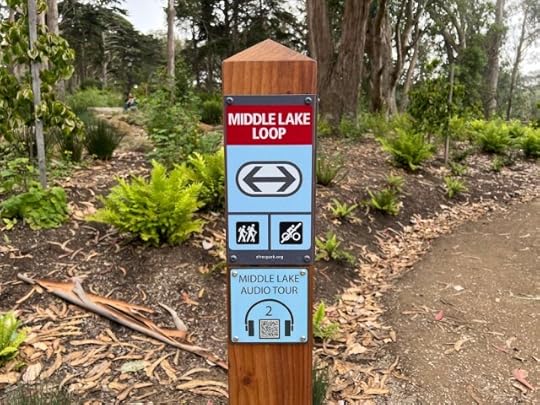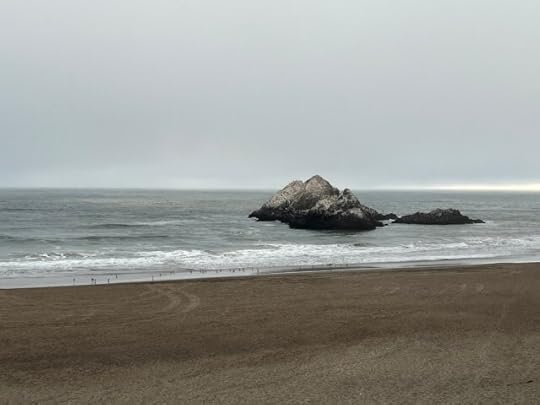Marc Weidenbaum's Blog, page 48
September 11, 2024
Mother Nature & Fate
Today turned out to be the first weekday in easily two months when the neighboring building wasn’t having construction done, and thus the unfamiliar relative quiet naturally made the rest of the world seem that much louder, all the more so because the world kept announcing itself with harsh gusts of wind and passing emergency vehicles, their sirens turned up to 11, so not merely the distant foghorns and muffled pedestrian chatter that are the usual hallmarks — if not quite soundmarks — of the neighborhood. And the sounds on my mind weren’t merely in the present tense. Building work like this seemed unlikely, from the start, to be that of an existing tenant, and lo and behold, new tenants are expected, and with them almost certainly new sounds following new daily rhythms. Perhaps the world was extra loud today to prepare me, to lower the likelihood of whatever new sounds are soon to arrive being experienced as especially intrusive. In other words, Mother Nature and Fate can already be depended upon to keep things interesting.
September 10, 2024
Tools of the Trade
Some writing essentials, based on my daily dependence:
▰ Obsidian — best note-keeping tool I’ve found, works cross-platform, syncs seamlessly (via iCloud and its own paid tier), and I’ve temporarily paused my use of Ulysses and Scrivener in favor of this for proper writing, both short-form and long-form (when I need an editor to take a look, I pop it into Google Drive, for which I’ve yet to find a worthy alternative)
▰ TextSniper — copy text from images, like PDFs, ads, and photos
▰ Dropbox — far from perfect but I haven’t found a worthy alternative
▰ MacWhisper — transcribes my recordings, as a solid subset of my notes over the course of the day are audio bits I tape on the fly
▰ Blurred — makes it (on a Mac) so all the windows except the active one are a little darker
▰ Reeder Classic + Feedly — I use this combo as my RSS reader, Feedly for the subscriptions and Reeder to actually read them (less cluttered than Feedly); you can use Reeder Classic with iCloud, but I found it slow
September 9, 2024
Middle Lake

The rehabilitation of Middle Lake in Golden Gate Park here in San Francisco is absolutely gorgeous, like someone put a Monet filter on it during the planning and construction. Bonus: there’s a two-track audio tour, accessible via QR code. I had to hit pause to figure out if birdsong was in the audio or reality.

At the moment, these are the only two tracks in the SoundCloud account of the San Francisco Recreation & Parks Department, soundcloud.com/sfrecpark.
September 8, 2024
On Repeat: Granular, Schulz, Suda
On Sundays I try to at least quickly note some of my favorite listening from the week prior — things I’ll later regret having not written about in more depth, so better to share here briefly than not at all.
▰ Quanta is the name of a granular synthesizer developed by Audio Damage, and a new version, Quanta 2, is due out soon. This is a demo in which a slow melodic sequence is echoed and otherwise blurred in real time.
▰ I believe the title of the new Jeannine Schulz release, Kanso, is from the Japanese for “simple.” It’s a pair of elegant ambient pieces, one gently industrial, the other more aqueous. Schulz is based in Germany.
▰ Nobuto Suda’s “Gazing the Sun Fading” is a hazy, loping ambient track that sounds like the sonic version of light glistening off a dirty windshield. And to be clear, that’s a compliment. Suda is based in Kyoto, Japan.
September 7, 2024
Scratch Pad: Pessoa, Foghorns, Corey
I do this manually at the end of each week: collating most of the recent little comments I’ve made on social media, which I think of as my public scratch pad. I also find knowing I will revisit my posts to be a positive and mellowing influence on my social media activity. I mostly hang out on Mastodon (at post.lurk.org/@disquiet), and I’m also trying out a few others. And I generally take weekends off social media.
▰ A bit of Fernando Pessoa after a very quiet three-day weekend, and as I’ve heard there’s something of a Brazilian social media diaspora underway:
I contemplate the silent pond
Whose water is stirred by a breeze.
Am I thinking about everything,
Or has everything forgotten me?
▰ The foghorns of the San Francisco Bay are doing Jaws karaoke again
▰ Me to my guitar teacher: “Instead of me trying to learn a new song at the same time as I am trying to learn to play it, how about I learn to play a song I already know well?”
Also apparently me to my guitar teacher, unwittingly: “How about I choose a song that changes from 4/4 to 2/4 briefly whenever it wants, and in which the melody is almost never the root note of the chord at the given time.”
▰ We’ve entered consecutive week 662 of the Disquiet Junto — which has been running since January 2012 — and I’m still astounded when within hours of the music prompt going out, recordings begin to pop up online.
▰ Yesterday in the car I got a Silver Alert on my phone at the same moment the driver got one and we were at a stoplight so after we turned off our alerts I could still hear the same alert klaxon ringing from the phone of the driver in the car next to the one I was in
▰ I was practicing on my parlor acoustic guitar and it was making the weirdest noise, a raspy resonance I’d never heard from it before, and I figured out that the snap on my shirt sleeve was resting near the bridge and ever so lightly vibrating. And yes, I’ll be recording, amplifying, and otherwise employing this analog effect in the future.
▰ I finished reading one novel this week, James S. A. Corey’s The Mercy of Gods. Corey is the name for the two authors who also wrote the Expanse books (and TV series).
September 6, 2024
September 5, 2024
Disquiet Junto Project 0662: Spin Cycle

Each Thursday in the Disquiet Junto music community, a new compositional challenge is set before the group’s members, who then have five days to record and upload a track in response to the project instructions.
Membership in the Junto is open: just join and participate. (A SoundCloud account is helpful but not required.) There’s no pressure to do every project. The Junto is weekly so that you know it’s there, every Thursday through Monday, when your time and interest align.
Tracks are added to the SoundCloud playlist for the duration of the project. Additional (non-SoundCloud) tracks also generally appear in the lllllll.co discussion thread.
Disquiet Junto Project 0662: Spin Cycle
The Assignment: Record a piece of music that pits one bicyclist against another.
Step 1: Imagine a bicycle race underway. Picture two competitors in the lead, running neck and neck for a long distance.
Step 2: Record a piece of music in which two prominent musical elements align, one each, with the two bicyclists in Step 1. How would you depict their rivalry as it unfolds, the give and take as each bicyclist strains to pull ahead of the other?
Note: You need not continue to the end of the race, when one or the other wins. You could simply focus on a segment of the race.
Tasks Upon Completion:
Label: Include “disquiet0662” (no spaces/quotes) in the name of your track.
Upload: Post your track to a public account (SoundCloud preferred but by no means required). It’s best to focus on one track, but if you post more than one, clarify which is the “main” rendition.
Share: Post your track and a description/explanation at https://llllllll.co/t/disquiet-junto-project-0662-spin-cycle/
Discuss: Listen to and comment on the other tracks.
Additional Details:
Length: The length is up to you. Is it a sprint or a marathon? How many loops?
Deadline: Monday, September 9, 2024, 11:59pm (that is: just before midnight) wherever you are.
About: https://disquiet.com/junto/
Newsletter: https://juntoletter.disquiet.com/
License: It’s preferred (but not required) to set your track as downloadable and allowing for attributed remixing (i.e., an attribution Creative Commons license).
Please Include When Posting Your Track:
More on the 662nd weekly Disquiet Junto project, Spin Cycle — The Assignment: Record a piece of music that pits one bicyclist against another — at https://disquiet.com/0662/
September 4, 2024
Alien Environment

Yes, I enjoyed the new James S.A. Corey novel, The Mercy of Gods. The depiction of alien life, consciousness, socialization, and habits in the book was very enjoyable. The duo who write as Corey established, in their previous nine-volume Expanse series, a predilection for micro-interactions and interior motivations, and it was excellent to see that play out amid myriad fantastic lifeforms. The main downside to The Mercy of Gods is realizing how much CGI overkill might be required to adapt this to the screen.
September 3, 2024
Perhaps “Brass Noise”
The musician who goes by the name id m theft able, and who is based in Portland, Maine, does these incredible videos where he places a tuba, amplified by a mic, in the environment and just records the resulting resonance. He does this with other instruments, as well, like the sound of light snow on a drum and freezing rain on a guitar. There’s a lengthy playlist of his tuba videos, which generally have prosaic titles, such as “A tuba by the falls (with a microphone in it) at dusk, April 19th 2020” and “A tuba at Whitney’s Falls (with a microphone in it), September 1st 2024.” The most recent id m theft able tuba video, “A tuba at one of the falls revealed when Dundee Pond was drained (with a microphone in it)” (note the absence of a date), was uploaded on September 3, 2024, and features a metallic drone that has the threatening vibrancy of a distant buzzsaw. It’s nearly 25 minutes of the deeply raspy rumble. The sound is sufficiently routinized and static to qualify as a colored noise, perhaps “brass noise,” rather than merely white or brown.





